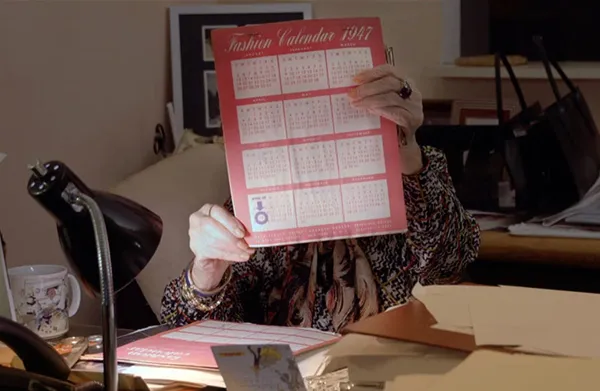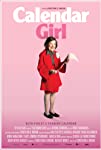Eye For Film >> Movies >> Calendar Girl (2020) Film Review
Calendar Girl
Reviewed by: Anne-Katrin Titze

Christian D Bruun's Calendar Girl on Ruth Finley, the creator of the Fashion Calendar, is a DOC NYC highlight. Other feature films of note include Chris McKim’s Wojnarowicz (on David Wojnarowicz); Nathan Grossman’s I Am Greta (on Greta Thunberg); Ulrike Ottinger’s Paris Calligrammes; Petra Epperlein and Michael Tucker’s The Meaning of Hitler; Oliver Murray’s Ronnie’s (on Ronnie Scott’s Jazz Club); Katja Hogset, Margreth Olin, and Espen Wallin’s Self Portrait (Selvportrettet) (on photographer Lene Marie Fossen); Yael Bridge’s The Big Scary "S" Word; and two shorts, Jennifer Callahan’s Making The Case on Ruth Bader Ginsburg’s handbags (thank you to Alessandro Nivola and Emily Mortimer) and Alison Klayman’s Flower Punk (on artist Azuma Makoto).
Calendar Girl (written with producer Natalie Nudell) features interviews with the who’s who of the fashion world (including Bill Cunningham; Carolina Herrera, who designed the white pantsuit and pussy-bow blouse Vice President-elect Kamala Harris wore on stage with President-elect Joe Biden; Thom Browne; Fern Mallis; former curator-in-chief of the Anna Wintour Costume Center at The Metropolitan Museum of Art, Harold Koda; Diane von Furstenberg; CEO of the Council of Fashion Designers of America, Steven Kolb; and an Andrew Bolton (the Wendy Yu Curator in Charge of the Costume Institute at The Metropolitan Museum of Art) stroll with Finley through the China: Through the Looking Glass exhibit.

Ruth Finley (who died in 2018 at the age of 98), had been an organisational maven of the fashion industry since 1941. She is lauded and celebrated for her life’s work behind the scenes in Calendar Girl. It is 2014, two weeks before Fashion Week in New York and she and her team of two (Mary Myers Hackley and Debbie de Monfort) are on the phones working out the scheduling, and by the copier to print the Fashion Calendar on pink paper.
Ruth was the mastermind deciding when which show was to take place to avoid conflicts among the designers. Carolina Herrera says that “Ruth was perfect solving problems.” Nanette Lepore enthusiastically praises Ruth for working with her on scheduling all of her shows. Diane von Furstenberg states that the first call always goes to Ruth. Bill Cunningham gushes about her outstanding quality: “She reached out and she helped young people.” Nancy Chilton [Chief External Relations Officer for The Met’s Costume Institute] speaks about Ruth adding humanity to the business and we see Ralph Lauren giving her a hug at the end of his runway show. Stan Herman, former president of the CFDA, says: “Nothing is like the CFDA. The CFDA is both the Senate and the House of Representatives.” Politics is never really far from fashion.
Ruth Finley’s son Larry Lein talks about what could have been an “impartial listing service” and how it all began. Ruth started the Fashion Calendar after graduating from college. Pink was chosen because the colour made it easy to find on a cluttered desk. As a child of the depression, Ruth Finley kept her office overhead low. She hired a speed typist to come in on Tuesday nights, her name was Doris Roberts, later actress in the sitcom Everybody Loves Raymond.
The structure of Calendar Girl is remarkable. From the general ideas on the art of scheduling for the fashion industry, the documentary moves closer and closer to Ruth Finley’s life and her as a human being, to then open the film up again to questions of business ethics, technology, and the importance of archiving. We learn about her marriages. The first husband, Hank Green, she says “was a nice person but wrong for me.”
Two sons and a divorce later, she married Irving Lein with whom she also had a son. Suffering a heart attack at 44, her second husband died and Ruth had to find a way to raise her three children on her own. “In my day it was not proper for women to work,” she states. Ruth never wanted to marry again, but we do get to meet her boyfriend, Joe Siegel (former Vice President of Bloomingdales), who calls her “Honey” and answers the filmmaker’s question what the private Ruth is like with “fun”, and “she’s worth a million.”
Nicole Miller explains a bit on the hierarchy and how she moved up from a 9:00am Tuesday slot to a coveted noon time years later. We see how the pre-computer shifting worked, with liquid paper and an active brain. Ruth herself never tired of going to as many shows as she could, always trying to wear the designers’ creations. At times she did 12 shows a day. The film touches on the beginning of 7th on Sixth with Fern Mallis, when the shows moved to the tents in Bryant Park, which helped centralise American fashion. With up to 300 shows, the calendar became bigger, featuring many more events than London, Milan, and Paris.
Most interestingly, the documentary takes us back in time to when Ruth Finley was hired as a girl Friday by the number-one fashion publicist, Eleonor Lambert, who was pivotal in getting American designers the recognition they deserved in the 1940s, with Paris being occupied by the Nazis. During the war, Lambert started “Press Week” at The Plaza or The Pierre in New York. In order to avoid scheduling conflicts of the shows for the buyers and press, the calendar was born.
“Ruth was Oz-like,” Steven Kolb says, working behind the scenes unlike Diana Vreeland (famed Editor-in-Chief of Vogue and curator at The Met Museum’s Costume Institute) or Lambert. There is great archival footage (even including a Donna Karan Dry Idea commercial) perfectly placed throughout by Bruun and his editor Rosie Nakamura.
After 69 years, Ruth’s office is closing and everything is packed in boxes to be archived. Mary pulls out an issue from ’47, which also included listings for movie openings and nightspots. It is obvious that there is a sense of nostalgia looking at old copies. When Ruth leaves her office for the last time, I was reminded of Richard Press’s Bill Cunningham: New York in which he is moving out of his apartment/studio in Carnegie Hall with all his boxes. Seeing her in the generic CFDA cubicle is chilling.
Archivist David Benjamin, makes clear what a treasure this is, a chronicle of the fashion world that does not exist anywhere else. “It’s like you’re archiving me,” comments Ruth. Koda and Fashion Institute of Technology Director Valerie Steele call it “incredible history.” Which gets us to the core of the film. The physical world on paper and the disappearance of history. The calendar is now completely online and several voices decry the lack of continuity. Thom Browne sums up well what is at stake with his plea to “put something in front of people that means something.”
The Covid-19 pandemic has of course had tremendous impact on what used to be Fashion Week, but the writing on the wall has been there for years and years, precisely because the “human element” was disappearing together with a sense of history.
Reviewed on: 18 Nov 2020
















